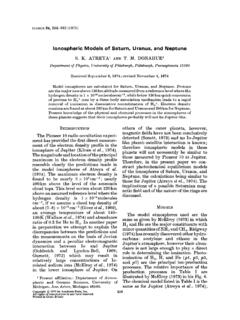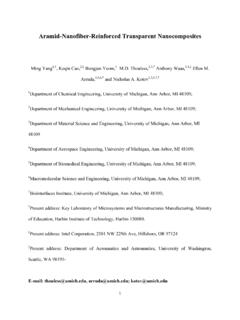Transcription of Linear particle accelerator (LINAC) - University of Michigan
1 Linear particle accelerator (LINAC) Seminar paper by Ivan Kunovi 12th January 2015 Page 2 Table of contents: Introduction .. 3 Parts of LINAC and their functions .. 4 How it works .. 5 LINAC in medicine .. 5 Examples .. 7 Page 3 Introduction A Linear particle accelerators have many applications: they generate X-rays and high energy electrons for medicinal purposes in radiation therapy, serve as particle injectors for higher-energy accelerators, and are used directly to achieve the highest kinetic energy for light particles (electrons and positrons) for particle physics. Linear particle accelerator (often shortened to linac) is a type of particle accelerator that greatly increases the kinetic energy of charged subatomic particles or ions by subjecting the charged particles to a series of oscillating electric potentials along a Linear beamline; this method of particle acceleration was invented by Le Szil rd.
2 Ionizing radiation in medicine works by damaging the DNA of cells including cancer cells.[2] Linac-based radiation therapy for cancer therapy began with treatment of the first patient in 1953 in London at Hammersmith Hospital, with an 8 MV machine built by Metropolitan-Vickers, as the first dedicated medical linac. A short while later in 1955, 6 MV linac therapy from a different machine was being used in the United States. [1] Figure 1 - Historical image showing Gordon Isaacs, the first patient treated for retinoblastoma with Linear accelerator radiation therapy (in this case an electron beam ), in 1957, in the [01] Today, LINACs are used all over the world and they are one of the primary methods for healing patients from cancer diseases.
3 They are getting more precise and focused only on contaminated tissue so the patients are getting more radiation on contaminated tissue and less on healthy tissue but with bigger power.[2] Page 4 X-Ray X-Ray Target A hollow pipe vacuum chamber Parts of LINAC and their functions Figure 2 Simple schematic of LINAC [02] The particle source ( Ion source in Figure 2). The design of the source depends on the particle that is being moved. Electrons are generated by a cold cathode, a hot cathode, a photocathode, or radio frequency (RF) ion sources. Protons are generated in an ion source, which can have many different designs. If heavier particles are to be accelerated, ( , uranium ions), a specialized ion source is needed.
4 A high voltage source for the initial injection of particles. A hollow pipe vacuum chamber. The length will vary with the application. If the device is used for the production of X-rays for inspection or therapy the pipe may be only to meters long. If the device is to be an injector for a synchrotron it may be about ten meters long. If the device is used as the primary accelerator for nuclear particle investigations, it may be several thousand meters long. Within the chamber, electrically isolated cylindrical electrodes ( drift tubes in Figure 2) are placed, whose length varies with the distance along the pipe. The length of each electrode is determined by the frequency and power of the driving power source and the nature of the particle to be accelerated, with shorter segments ( l1 in Figure 2) near the source and longer segments ( l4 in Figure 2) near the target.
5 The mass of the particle has a large effect on the length of the cylindrical electrodes; for example an electron is considerably lighter than a proton and so will generally require a much smaller section of cylindrical electrodes as it accelerates very quickly. Likewise, because its mass is so small, electrons have much less kinetic energy than protons at the same speed. Because of the possibility of electron emissions from highly charged surfaces, the voltages used in the accelerator have an upper limit, so this can't be as simple as just increasing voltage to match increased mass. One or more sources of radio frequency energy ( RF source in Figure 2), used to energize the cylindrical electrodes.
6 A very high power accelerator will use one source for each electrode. The sources must operate at precise power, frequency and phase appropriate to the particle type to be accelerated to obtain maximum device power. Page 5 An appropriate target. If electrons are accelerated to produce X-rays then a water cooled tungsten target is used. Various target materials are used when protons or other nuclei are accelerated, depending upon the specific investigation. For particle -to- particle collision investigations the beam may be directed to a pair of storage rings, with the particles kept within the ring by magnetic fields. The beams may then be extracted from the storage rings to create head on particle collisions.
7 Additional magnetic or electrostatic lens elements may be included to ensure that the beam remains in the center of the pipe and its electrodes. Very long accelerators may maintain a precise alignment of their components through the use of servo systems guided by a laser beam . [1] How it works Ion source gives bunch of electrons which are then accelerated towards first drift tube (Bottom scheme in Figure 2) because of their negative potencial and drift tube s positive potencial. When electrons comes inside tube, in that moment RF source shifts its polarity. First drift tube then becomes negatively charged and secon drift tube positively charged. Electrons comes outside of tube because of its inertia and in that moment they are pushed with first drift tube and attracted by the second one in the same direction (Top scheme in Figure 2).
8 As electrons are accelerating, their velocity becomes bigger and they travel longer distance in the same time. That is the reason why drift tubes must be longer as electrons comes closer to target; because of their greater velocity. If very great velocity is needed, because of long drift tubes and big number of drift tubes, linac must be very long. As the particle bunch passes through the tube it is unaffected (the tube acts as a Faraday cage), while the frequency of the driving signal and the spacing of the gaps between electrodes are designed so that the maximum voltage differential appears as the particle crosses the gap. This accelerates the particle , imparting energy to it in the form of increased velocity.
9 At speeds near the speed of light, the incremental velocity increase will be small, with the energy appearing as an increase in the mass of the particles. In portions of the accelerator where this occurs, the tubular electrode lengths will be almost constant. [1] LINAC in medicine Radiosurgery can be performed with Linear accelerator machines. By definition, radiosurgery is a one session surgical procedure directed by a neurosurgeon and a radiation oncologist. The entire procedure occurs in one day, including immobilization, scanning, planning and the procedure itself. With radiosurgery, the radiation dose given in one session is usually less than the total dose that would be given with radiation therapy.
10 However, the tumor receives a very high one time dose of radiation with radiosurgery, and smaller doses over time with radiation therapy. Currently, there is marketing from hospitals, physicians and manufacturers of newer Linear accelerators to entice patients to use their machines, which would result in more profits. Much of the marketing is not supported by evidence-based outcome studies which have been peer reviewed and published. In one case, most of the published research has been conducted by the developers of the machine, which is privately owned by a group of investors. Linac technology is most often used in multi-session treatments in order to not do damage to healthy surrounding tissue. The total dose of radiation is higher than with one session radiosurgery, but it is given in several smaller amounts, which may allow the tumor to continue growing.











![arXiv:2203.06454v1 [physics.plasm-ph] 12 Mar 2022](/cache/preview/9/2/6/d/f/a/8/1/thumb-926dfa81e51e569016b61e30d7be9ca5.jpg)



